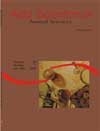<b>Quality of pork cuts from swine receiving ractopamine as ration in different feed programs</b> - DOI: 10.4025/actascianimsci.v30i2.4682
Keywords:
carcass modifier, feed restriction, belly, tenderloin, ham
Abstract
This study evaluated the supplementation of ractopamine associated with feeding restriction in diets with high lysine content on the composition of pork cuts. Thirty barrows (107.2 ± 6.2 kg) were utilized, receiving the experimental diets during 28 days before slaughter. The randomized block design was applied in a 2 x 2 + 1 factorial (two levels of ractopamine – 0 or 5 ppm – in rations with 1.03% of total lysine; ad libitum or 15% feed restriction; and a control treatment, ad libitum, without ractopamine, with 0.8% of total lysine) with six replicates. The cuts were obtained from the left chilled carcass. The tenderloin percentage (RFIL), the ham (PCPER), shoulder (PCPAL), boneless shoulder (PCSOP) and bone-in loin (PCCAR) meat percentage, the average thickness (EB), flexibility (FB), amount of meat (QCB), fat (QGB) and meat:fat ratio of the belly (RCGB) were evaluated. The ractopamine increased RFIL, PCPER, PCPAL, PCSOP, PCCAR and RCGB when compared to diets without ractopamine and 1.03% of lysine. Compared to the control, ractopamine increased PCCAR and RCGB; decreased QGB; and when associated with the feed restriction, increased PCPER. Feed restriction decreased FB. The use of ractopamine increases the meat percentage in pork cuts and feed restriction decreases FB.Downloads
Download data is not yet available.
Published
2008-08-07
How to Cite
Cantarelli, V. de S., Zangeronimo, M. G., Almeida, E. C. de, Wolp, R. C., Pereira, L. de M., & Fialho, E. T. (2008). <b>Quality of pork cuts from swine receiving ractopamine as ration in different feed programs</b> - DOI: 10.4025/actascianimsci.v30i2.4682. Acta Scientiarum. Animal Sciences, 30(2), 165-171. https://doi.org/10.4025/actascianimsci.v30i2.4682
Issue
Section
Nonruminant Nutrition
DECLARATION OF ORIGINALITY AND COPYRIGHTS
- I Declare that current article is original and has not been submitted for publication, in part or in whole, to any other national or international journal.
The copyrights belong exclusively to the authors. Published content is licensed under Creative Commons Attribution 4.0 (CC BY 4.0) guidelines, which allows sharing (copy and distribution of the material in any medium or format) and adaptation (remix, transform, and build upon the material) for any purpose, even commercially, under the terms of attribution.
Read this link for further information on how to use CC BY 4.0 properly.
0.9
2019CiteScore
29th percentile
Powered by 








































